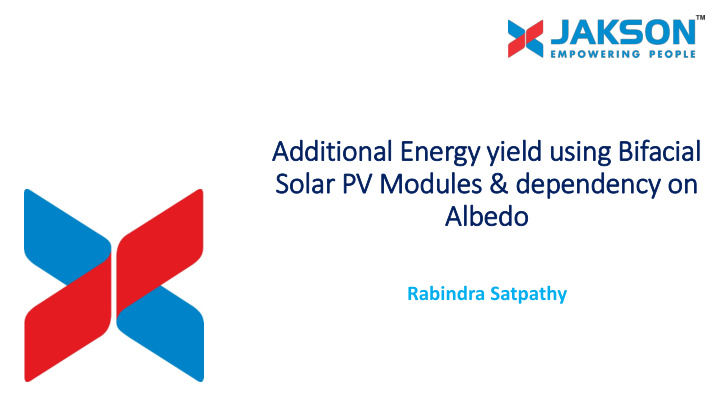



Additi tion onal E Ener ergy y yiel eld u using B Bifaci cial Sol olar P PV Mod odule les & & dep ependency cy on on Albedo Rabindra Satpathy
Monofacial vs Bifacial Modules Bifacial Monofacial The data sheet specifies the rear side power based on albedo factor for 345W module Source: Adani
Contributions t to En Energy Y Yield Bifacial Energy Gain Depends on 1. Type of solar cell used for the module and the Bifaciality factor 1. Bifaciality factor of different Bifacial solar modules cell- PERC+ >70%, PERT >90%, HIT >95%, IBC >70% If Bifacialty factor is more, the energy yield is also more 2. Location of site: Content of diffused radiation and direct radiation affects the energy yield Latitude decides the tilt angle of the mounting system. If diffused radiation content is more, there will be more generation. 3. Tilt angle : Tilt angle increase will cause increased reflected light and hence contributes for energy yield
Contr tributi tions o of f Albedo to En Energy Y Yield 4. Type of horizontal surface , from which the reflection is coming Surface Type Albedo and its reflectivity ( Albedo factor) Green Field grass 23% 5. Row to Row distance: If inter row space is increased reflected light Concrete 16% will increase on rear side and hence contributes for energy yield White Painted Concrete 60-80% White gravel 27% White roofing metal 56% Roofing membrane Light- grey 62% Roofing membrane - White >80% Data Source : https://solarkingmi.com/assets/How-to-Maximize-Energy-Yield-with-Bifacial-Solar-Technology-SW9001US.pdf
Contributions of Height to Energy Yield 6. Elevation and Height of Structure Flush mounting blocks the light on rear side Less height cause self shading on rear side of module 30 degree tilt, 2.5 mtr Increasing the height up to 1 mtr will increase the reflected light and inter row space, 80% boosts the energy yield albedo factor Source : Solar World white Paper Source : PVTech By Joris Libal and Radovan Kopecek
Contribution of Tracker/ mounting to Energy gain 7. Usage of Single axis tracker , enhances the reflected radiation on rear side and boosts the energy up to 15% Source :Longi Solar 8. Vertical mounting with E-W direction generates more energy yield for higher latitudes (NREL study)
Study by Sandia National Laboratory-USA The average daily power curve for bifacial modules (solid lines) vs mono-facial modules (dashed lines) in 5 different test conditions, which Sandia measured over a 6-month period at its New Mexico Regional Test Center Bifacial gain vary throughout the day The bifacial contribution is more in morning , evening and during cloudy conditions Bifacial modules out performing from 18% to 136% compared to monofacial modules Source : Solar Pro issue 10.2
Study by Trina Solar Trina Solar set up a test in Changzhou, China, to find out Module Mounting Bifacial gain how much more energy bifacial modules generate On grass 5.20% compared to Mono-facial modules. On grass with a tracker 10.57% On sand 10.79% Combined with a tracker and placed on a white-painted On sand with a tracker 24.42% surface, bifacial modules outperform the standard mono- On white-painted surface 21.90% facial panels by more than a third. On white-painted surface with a tracker 33.20% Source : Trina Solar
Study by Solarworld Bifacial gain in energy (BGE) increases with θ: tilt angle of modules h: height above the ground α: albedo of the ground BGE(%) = A*(θ)+B*(h)+C*(α) Where A,B,C are Numerical coefficients High albedo gives higher energy yield Higher the installation height of the module, higher the energy yield Bifacial boost is greater on days with lower insolation Bifacial modules provide a considerable performance boost even in less than ideal circumstances Source : White Paper Solar World
LCOE Prediction by Longi Solar Source: Longi Solar
CONCLUSION The Bifacial solar PV modules gain in energy, depends on Module Bifaciality Factor, Albedo factor & the Height of the module Bifacial performance is quite sensitive to enhanced albedo of the ground surface. E-W bifacial vertical modules, which can outperform optimally oriented mono-facial modules, especially with enhanced albedo. Vertical E-W bifacial modules produce energy in the morning and evening of the day than S-facing arrays. Bifacial modules significantly outperform mono-facial modules in conventional designed systems. Additional performance benefits from bifacial modules are possible with optimized system designs that enhance albedo, avoid backside obstructions and minimize ground shading beneath the array. Careful design and Parameters choice of both modules and field installation will insure Bifaciality gain of 30-40% LCOE will drop below 5 US cents/kWh
THANK YOU
Recommend
More recommend